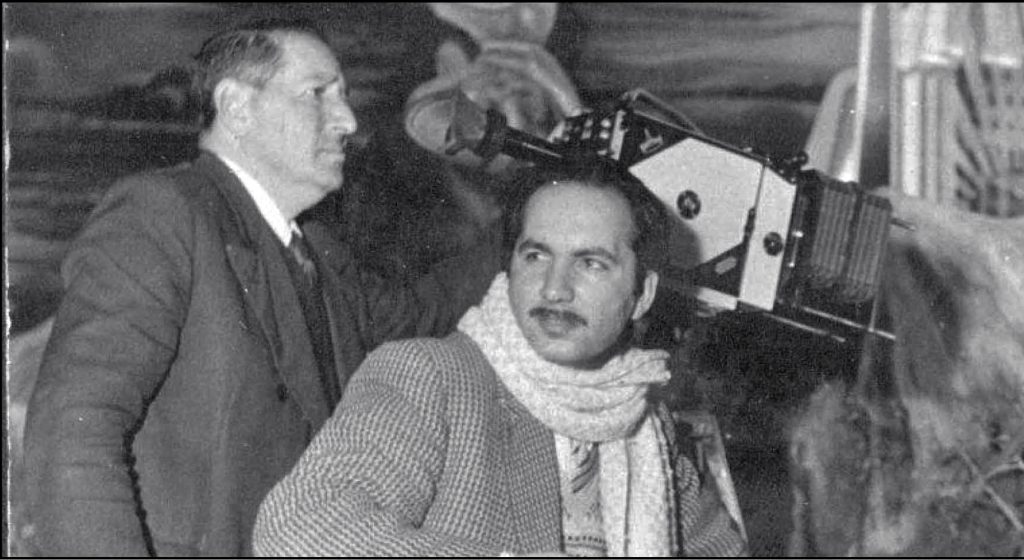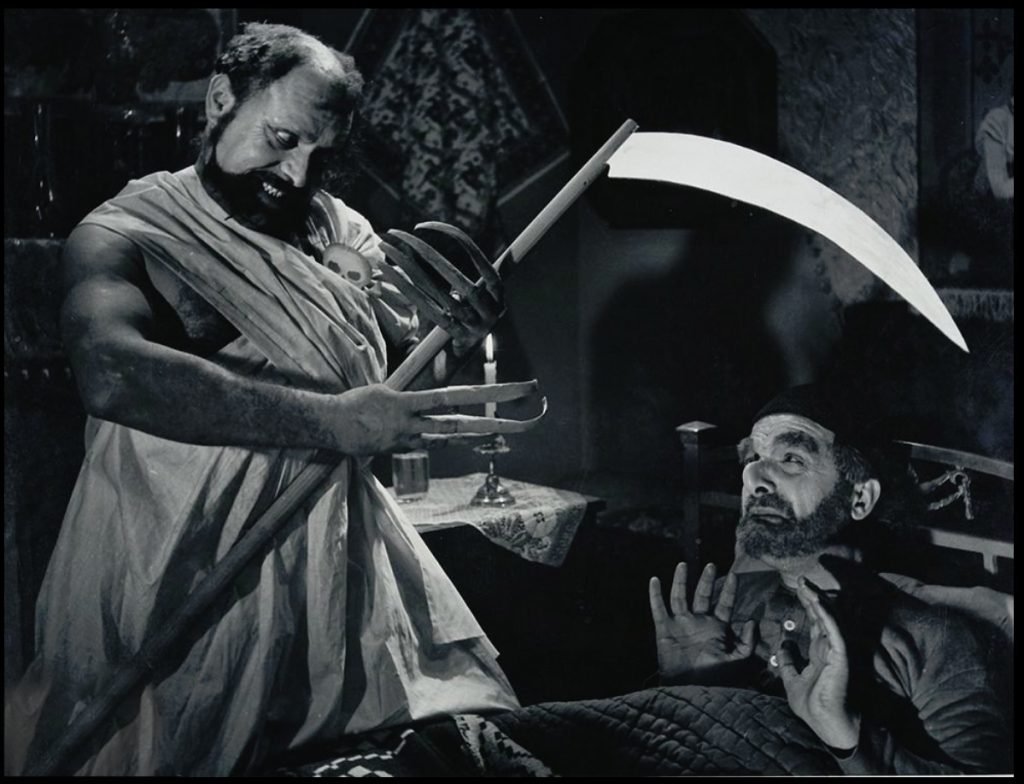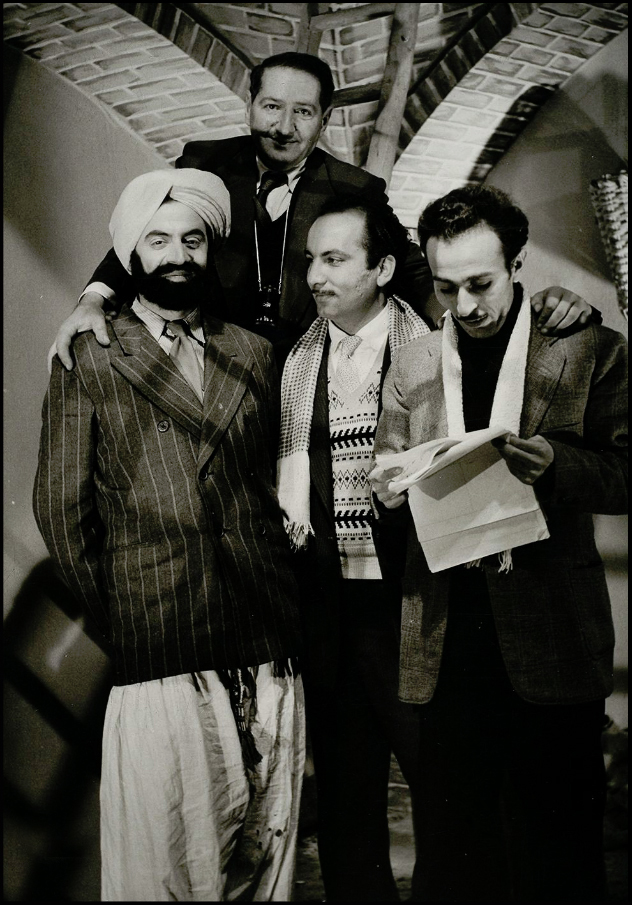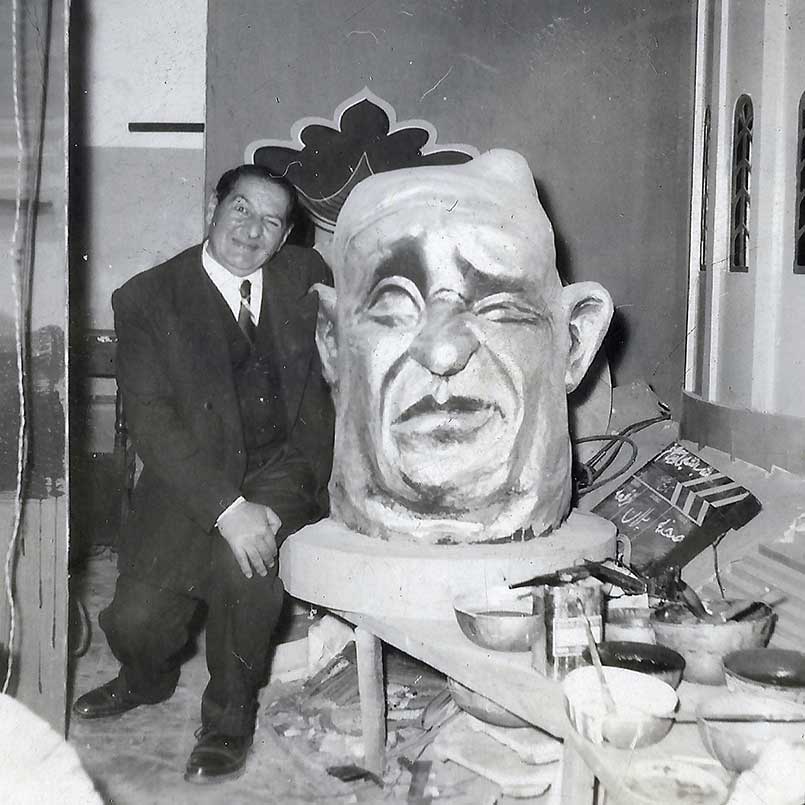Soiree in Hell – The Untold Story of My Grandfather
Soiree in Hell is an Iranian comedy thriller movie directed by my grandfather Mushegh Sarvari (AKA Sarvarian) which competed next to Ingmar Bergman’s Wild Strawberries and Vittorio De Sica’s Anna of Brooklyn in the 8th Berlin International Film Festival in 1956 and was acclaimed by critics for it’s innovative production design and art direction, another feature that was entirely designed by Sarvarian.
The film tells the story of ethical and emotional transformation of a rich but greedy man from evil and stinginess to becoming kind and giving. The main character, Haj Jabar, experiences his transformations from bad to good by learning his lessons of not being greedy through his life changing dream; a dream, in which he finds himself wandering in hell, encountering angels and demons, Uncle Sam, Hitler, Napoleon, rock & roll dancers and finally god himself (well a male character is portrayed as god or his re-presenter, hence I used “him”, otherwise no chauvinistic sentiments here!) that gives Haji Jabar a new understanding of the meaning of life. The basic idea and the context of this story has similarities to the novel of “ A Charismas Carol” by English author Charles Dickens. Here the main character Haj Jabar supposedly resembles Ebenezer Scrooge’, a character who also experience an emotional transformation from bad to good through supernatural visits of a ghost friend. The movie was however, influenced by a play named Vadang in which one of the key actors Erham Sadr had the main role. Allegedly the producer of this movie, Mehdi Misaghieh, travelled from Tehran to Isfahan to see Vadang on a stage and eventually that became the idea for him to write the screenplay for Soiree in Hell. (Info on Iranian Cinema)

Soiree in Hell was very successful upon its first release and broke all the Iranian box office records up to its date with a groundbreaking 800.000 Tooman gross income. The record remained untouched until about ten years later when the most successful Iranian film “Ganje Gharoon” was out. (A successful melodrama film-Farsi that becomes very famous among the people, and especially the working class, as it was a representation of their society. Director Siamak Ghasemi’s movie’s success was never repeated until after Iranian revolution in 1979)
Beside all the regular movie theaters across country , Soiree in Hell unexpectedly was screened in Metropole, Iran and Plaza cinemas that usually were not displaying any domestic products up to that date, but the owners of the theaters found the film worthy enough to be a part of their selections . The movie was also entered into the 8-th Berlin film festival, the first Iranian film to be admitted to a major foreign film festival to that date. In my opinion, the major reason that “Soiree in Hell” stands out as one of the most important films of the Iranian cinema is the highly detailed, ingenious and inventive scenes that makes up the second half of the film where the main characters, Haj Jabar and Ebram, wander through the porches of hell and allow the audience to experience some great visual representation of the heaven and hell from the point of view of Iranian culture. These scenes of the movie present the world of the dead with such a creative and strong fantasy that it’s hard to believe that this film was made about 60 years ago, especially considering all the technical and technological adversities of its era. Beside the outstanding fantasy leading to exceptional set decoration, some witty dialogs, creative make up designs and superb cinematography also became instrumental elements that combined together make “Soiree In Hall” a pivotal achievement in the Iranian film history.

Plot:
Despite the similarity of this movie to the westernized story of The Christmas Carol, there were also many differences to the point where the story takes its own path. Filming partly in actual locations in the most important city of the Middle East at that time (Tehran), has given the movie scenes and sets a rich and genuine glimpse of Iranian culture and traditions. The opening scene of the film starts with the morning call of prayer (azan), and then we meet Haj Jabar, portrayed by “Ezatolah Vousoogh” who is too busy counting his money and mumbling about how rich he is to pay attention to the morning call of prayer. His greediness is extreme to the point that takes away his attentions and love from his own family. Jabar is portrayed as a stone hardhearted man, who yells and disrespects all inferiors. He is seen to yell at beggars to take a hike, yell at a widow tenant and her children by threatening them to be tossed out on the street, he even yells at his kind hearted and witty assistant, Ebram, played by Erham Sadr, the famous Isfahani comedian. Despite Haj Jabar’s enormous fortune, his family is living a miserable life. His daughter, Parvin, here portrayed by Iranian superstar of the time “Rofia” is in love with her cousin and wants to marry him; (She apparently didn’t know at that time that marrying a first cousin increases the risk of autosomal recessive genetic disorders ) however Haj Jabar is completely against this marriage and in fact, he is scheming to marry her off to a rich old guy, A Turkish merchant. There is even a scene that the daughter and long-suffering wife tries to chide Haji for being greedy or try to get some freedoms, he berates them and slams his daughter’s head into a table (Ouch!). Parvin expresses her emotions by singing a sad song, largely to her caged bird, which is an obvious metaphor of herself being imprisoned. Jabar’s son also is leading a suffering unhappy life as he was banned from continuing his education by Haj Jabar. The son’s character is portrayed as a young hopeless gambler that spends his days in the nightclubs and drinks to forget about his goals. (So far very Filmeh-farsi)

The exciting and entertaining part of the story begins when a man who is aware of Haji Jabar’s money and whereabouts, tries to sneak into Jabar’s house and attempt a rubbery. Ebram on the other hand, aware of his actions, follows him to Haji’s house. There is a sequence where in the darkness, the thief unknowingly sits on Ahmad’s lap, and every stack of money the thief puts in his pockets, Ahmad then takes it out and puts in his own. The whole sequence plays out like a type of Marx brother’s comedy. This scene later is incorporated in a part of Mohsen Makhmalbaf’s homage to Iranian cinema “Nasereldin Shah the cinema actor”. Finally Haj Jabar notices the thief in his house and tries to capture him, however in a series of comedic back and forths he ends up falling in the pool of his house, almost drowning himself and Ebram, eventually falling sick as the thief is caught by the local police .

“Shab Neshini Dar Jahanam” kicks into high gear by seeing Haj Jabar being awaken by sound of a freaky laughter that comes from a being with a strange hairstyle and a skeleton on his chest. He has long, sharp clawed fingers, and he represents himself as Ezrail, known in Iranian and Islamic culture as the angel of death. The freak out ends as Haji found himself and later his assistance in a middle of a surrealistic Jungle. He then meets Adam and Eve as Adam complains that Eve asks for nylon bra! (WTF?) There are impressive mountains and flame shooting in the lake of the fire. Haji and Ebram attempt to enter heaven, but the only way to win a ticket into heaven is by walking across a bridge that is more like a tight rope. However, there is an angel on the other side who prevents their entrance into heaven cutting the rope and rejecting them to get into the heaven. Later both find themselves, in a cave, more like hell, where people are dancing in one side of it while on the other side a bunch of slaves are being chained and whipped by an Uncle Sam figure with all the oil wells behind him. This unambiguously represents the director’s anti-imperialistic approach, one that is clearly noticeable in his paintings and comic strips that he would publish in his established Armenian weekly magazine “Nor Hasker – The New Grapes” a publication with very liberal and leftist views that signifies another side of Sarvari’s activism in politics and social justice.

Later there are also multiple scenes where Haji and Ebram encounter many famous dead people including actual Indian actor Raj Kapoor (Played by himself) Roman crazy emperor Neron (Played by Sarvari’s nephew Zareh Balasanian), Frankenstein (Played by Sarvari’s other nephew Edik Balasanian), Hitler, Napoleon, and Genghis Khan while these two are constantly pursued by the devils who don’t want them in hell illegally. Next we see Haji and Ahmad stumble across a rock and roll dance marathon as people dance to a new record that has just arrived from the other world. This scene hilariously implies the effects of pop culture in Iran about 60 years ago. The group dancing with the beats of one of the earliest rock’n roll songs consist of a youth group who were attending the school established by Sarvari’s mother at that time known as “ The Children Palace – Kakh-e Koodakan” and it creates one of the most upbeat and funny scenes of the movie. Finally Ebram and Haji are captured and brought to a building that looks like a hall of Judgment or court. Both Haji and Ahmad are to be judged in the court of god for their afterlife’s destiny. This is the moment where they would learn if they belong to hell or heaven. The presence of late Maziar Parow, the legendary Iranian cinematographer acting as God’s left hand is worthy of attention in this very scene. As expected Ahmad, being a good caring man, get to go to heaven and Haji stays and pays off his guilt by being turned into a dog and thrown in the fires of the hell. (Brutal!)
All of a sudden, we see Haj Jabar jumps up from his bed, and realizing he had a nightmare he changes from a greedy man to a good giving man. He lets his daughter to marry the man she is in love with and donates his money to charity. Few moments later he dies peacefully and again we see him passing the gates of heaven only this time with an angel welcoming him with a wide smile as the other angels are flying his royal, mystical stagecoach.

Key Players:
The main character of this movie, Haj Jabar was played by Ezzatollah Vosoogh. He was born in 1993 in the city of Bakoo from Iranian parents. He educated and graduated from an Art Film school in 1932 and began his career as a stage actor in 1933. His most influential professor was Ali Daryabegi who was very important on him for accomplishing his success in his career. He begins his first role as an actor in Iranian cinema in the movie of Afsoongar. He appeared and played roles in 42 movies, but gained his fame from the movie of Soiree in Hell. He mostly played movies that had the theme of Film-Farsi, comedy or thriller and despite his artistic capabilities rarely appeared in any Art films. His unique style of acting was influential on the young actors of Iranian cinema and many looked up to him as their own role model. It’s been said that he went through shocking experience after his wife death’s that made him mutant for several years. He passed away in 1991.
The Assistance of Haj Jabar, was played by famous theater comedian from city of Esfahan, Erham Sadr. He was known to be the master of spoken comedy. Born in Isfahan in 1923, Erham began his education in an English college in Isfahan and experienced his first act on stage during his high school years, where he participate in a play which brought him success through selling out for seven consecutive nights. He, then officially began his career as a stage actor in 1947, and went on to establish Erham Sadr Art Organization in 1964 (Info on Iranian Cinema). Soiree in Hell was his first movie in Iranian Cinema where he was paid double amount of salary than the main character, Haj Jabar. After the Islamic revolution, Erham was banned from acting and unable to pursue his career he passed away in 2008.
Female actress, Roffia, Haj Jabar’s daughter was a very well known actor and a singer. She was very famous that her name was to be one of the first to be shown in the opening credit even though she was not meant to play as one of the main characters. Her songs in this movie were performed by Delkash, the famous Iranian singer who was the biggest star of Iranian music industry. The male characters songs were song by a young Armenian called Vigen Derderian who later revolutionized the Iranian music and was rightfully dubbed as the Iranian Sultan of Jazz music.
The Triangle of controversy
Shab Neshini dar jahanam was directed by Mushegh Sarvari. He was born in 1910 to an Armenian Family. He began his education in the Art school of Saint Luye and started his creative career as a graphic designer and book cover stylist. He designed many posters and ads for variety of movies and corporations and with the help of his brother Napoleon Sarvari established the first graphic design studio in Tehran’s Lalehzar neighborhood and very soon they were the ones designing the posters for most of the shows and performances in the nearby theaters. Iranian famous graphic design mentor Morteza Momayez rightfully names the Sarvari brothers as the forefathers of Iranian Graphic design industry. Mushegh also worked as a set decorator for movie sets in Iranian Cinema and eventually found his love and interest in making films soon switching his career from a graphic designer to a filmmaker. Sarvari’s directing debut was with Mahatab Khoonin “ The bloody moon”, made in 1956 co-staring his own son Leonid Sarvari(ian). Later he also made a sequel to “ Soiree in Hell” called “ Haji Jabar in Paris”. During production of the later and due to a silent boycott running around his production he faced lots of adversities, which eventually resulted in him having financial crisis once the film sank in the box-office.

Mehdi Misaghieh, the producer of the movie, was born in 1928 to an Iranian Family in the city of Tehran. He began his career in Cinema as an actor, but later continued his love for cinema as a producer. He was the founder of Misaghieh Studio in 1953. He also established two more Kaperi and Farhang cinema. He passed away in 1991.
I hereby include Samvel Khachikian, another Iranian/Armenian filmmaker’s name, to shed light on an old controversy that has been speculating since the earliest years of the film’s release suggesting him as a part of the film’s production crew. Samuel Khachikian, who in some sources is incorrectly credited as the co-director of the movie, was born in 1923 to also another Armenian Family in the city of Tabriz. He graduated as a journalist but worked as a filmmaker and director in the early stages. Not being an established director at that time, Misaghiyeh signed a contract with him to make five feature films. About the same time, Khachikian, being a talented and aspiring filmmaker was also invited through Misaghieh as a part of the creative team to help Sarvari who was the director and set designer of Soiree in Hell, but later when the film made big in the box-office, Misaghiyeh, being a businessman in the first place, using the public sensation made by “Soiree In Hell” decided to credit Khachikian as the co-director to promote his upcoming projects meanwhile retorting Sarvari who after some arguments with Misaghiyeh was planning to shoot a sequel to “Soiree in Hel” called “Jabar In Paris” all by himself, now that he had already established his own studio called “Sarvari Film” by this point.
For those familiar with the unique style ofKhachikian, who later well deservedly became to be known as “ The Iranian master of suspense” or “the Iranian Hitchcock” by making horror and trailer movies and not comedies and fantasy stories, and also considering the fact that in the official release of the film Khachikian’s name is not credited as a director, it can be pretty clear that Sarvari is the sole director of the movie. Also bearing in mind that all the testimonials in this regard, made by reliable sources amongst them the cast and the crew of the film confirms Sarvari’s position, in addition to the fact that Sarvari’s unique signature style ( one that if studied closely can be referenced to his other films and design works) can serve as strong proof to understand that all the speculations on film being made by two directors is simply a hoax made by the producer to pursue some marketing and personal agendas without having legitimate bases and facts. In addition, Khachikian has made plenty of great movies that even without “Soiree in Hell” in his filmography list, would endure him as a major Iranian cinema figure, while as for Sarvari due to financial and political problems there has never been another chance to prove his genius and “Soiree In Hell” along with three other movies are the only remaining works left from him in the field of cinema.

Historical Context:
The storyline and the movements were very responsive to the social milieu. People were able to see the portrayal of their own life through Soiree in Hell. Haji was the representations of a male dominate family in which the father is the head and his words and his actions must be respected and accepted with no questions asked. The role of mother, Haji’s wife, was one of the most typical mom characters. The kindness of mother and the warm feeling given by her was influential on many other Iranian Films in which they repeatedly depicted this similar Mother character mostly portrayed by “ Parkhideh” who continued to act in the same style in over 30 other films. The role of the daughter, her dream of being free, and independent decision maker for her own life is the reflections of many Iranian girls’ dream in that decade. Girls were able to identify themselves through this character as Parvin, who was a representation of their feelings. Also the son’s life of being a gambler/ loser kind was a typical example of the parent’s negligence toward their child’s dreams. The fact that characters were representing the social lives of Iranians of 1950’s , was very influential, that people started to blend the movies aspect into their everyday life. For example Haji’s role was blended in the Iranian social life physically and verbally. People would intimate his voice, his slangs, his movements, and his way of dancing as if the Iranian culture has added the Haj Jabar’s style into itself. In all, it can be said that one of the aspects that this movie gained fame was its story fitting into everyday life of the people despite half of it taking place in hell.

Technical aspects:
It must be known that Sarvari’s experiences as graphic designer had added a very unique taste to this movie that attracts the audience. The wild underworld scene was designed and created by him who was able to bring a great entertainment that was not seen before in any other movie in the history of Iranian Cinema. There were also many new techniques used in the cinematography of the film; the usage of new camera filters, superimposed imaging, dolly shots and other especial effects were the first to be seen in Iranian Cinema.
The set-decorations not only had the purpose of entertaining; they were also symbolic and had deeper meanings. The film represented the issue of morals through religious concepts. Many scenes of this movie, especially from the hell, were depicting anti-imprialistic and anti-war meanings. We see Uncle Sam lashing on people in the hell while they are working like slaves and in the background there are the images of oils and money. Despite all this technical achievements the film still falls under the category of film-farsi. This is in many ways because of the general culture of moviegoers who would pay to see dancing, singing and sex and farce comedy in movies. Misaghiyeh knew the taste of his audience and he would push his crew to include those elements in the film. In result, Dr. Houshang Kavosi (Famous Iranian film critic aka the Roger Ebert of Iran.) attacks the film arguing that the movie, unlike what it may seem, doesn’t signify an important landmark in Iran’s cinema and the characters are the same that we see in all other film-farsi versions, however, Farokh Ghafari, a more moderate film critic, believes that this film deserves to be noted for it stands as one of the few to have a clean and quality sound design, proving that the audio labs in Iran had improved to a certain level at that time. Also he praises the design of the set decorations and believes that they are made with extreme care to details. In general, the movie may have received very positives criticism from its audience who were the ordinary people. However, it was not positively criticized by the religious people. They had an opposite reaction toward this movie which was not appreciated. They believed that the philosophy of hell, the belief of after life was misleading and insulting. It is sin to portray hell. (Matin, 2007) They believed these images will bring stereotype that are not necessary true. And people will become unfaithful toward their god, and their religious behavior.
